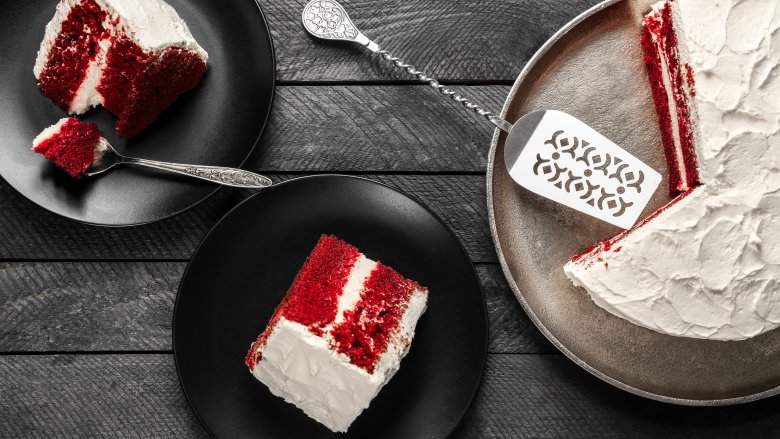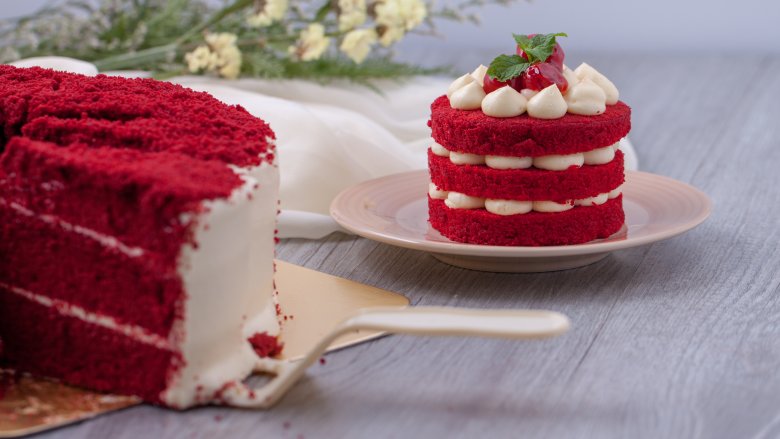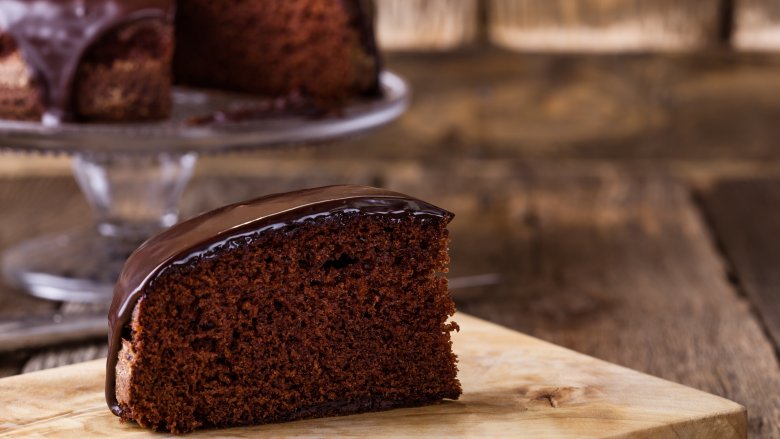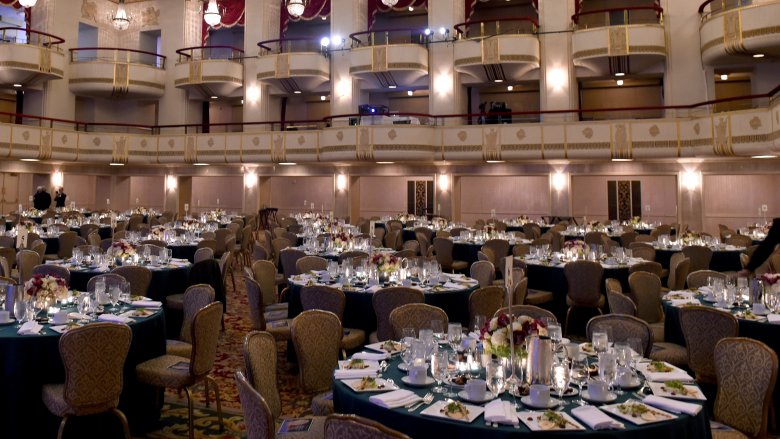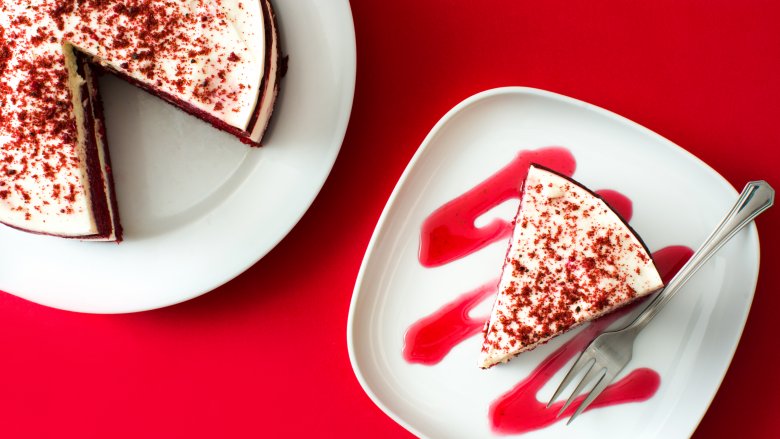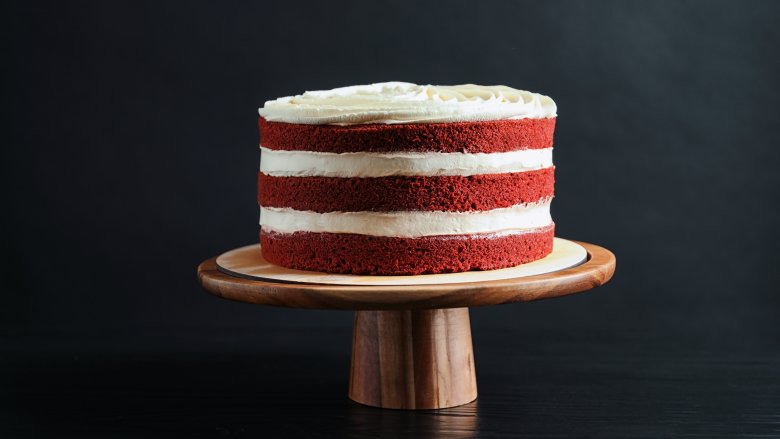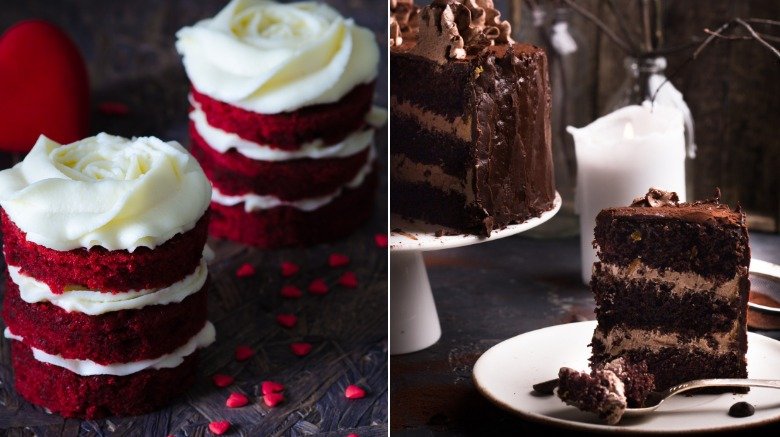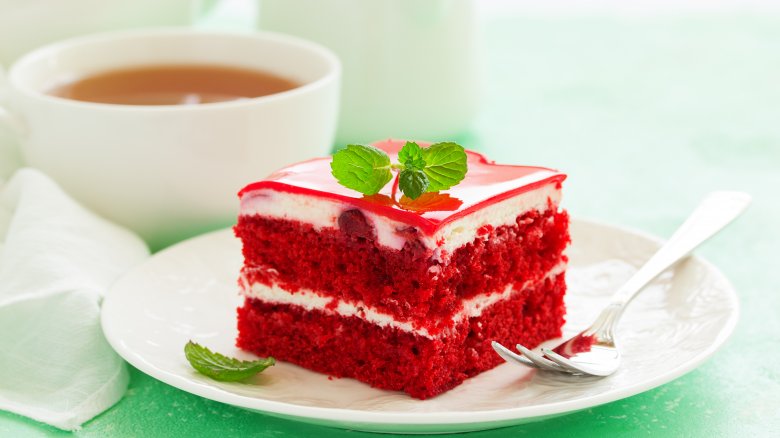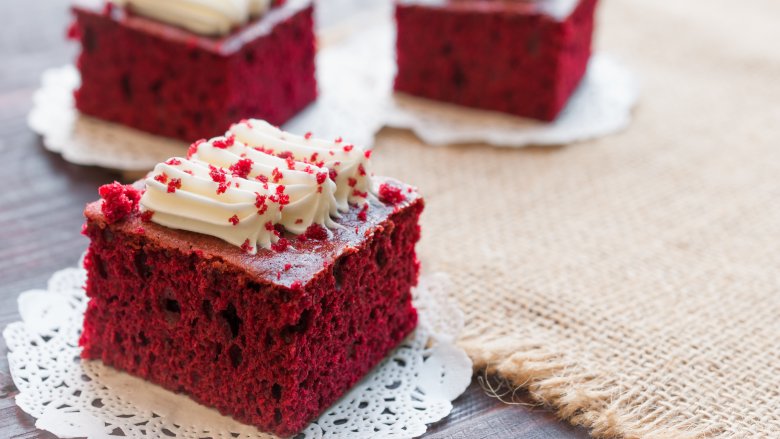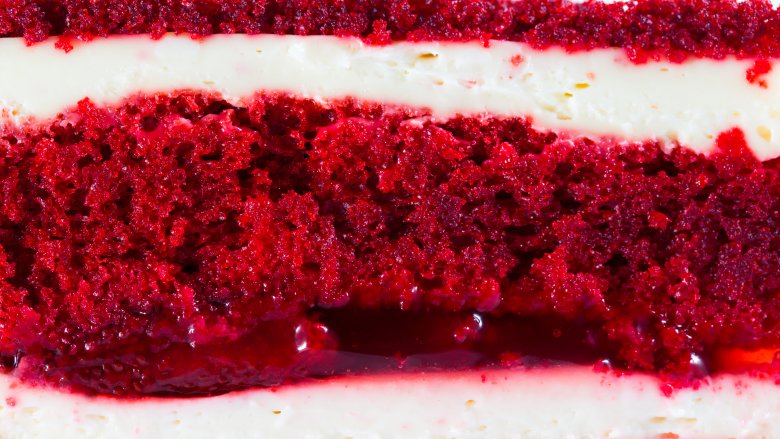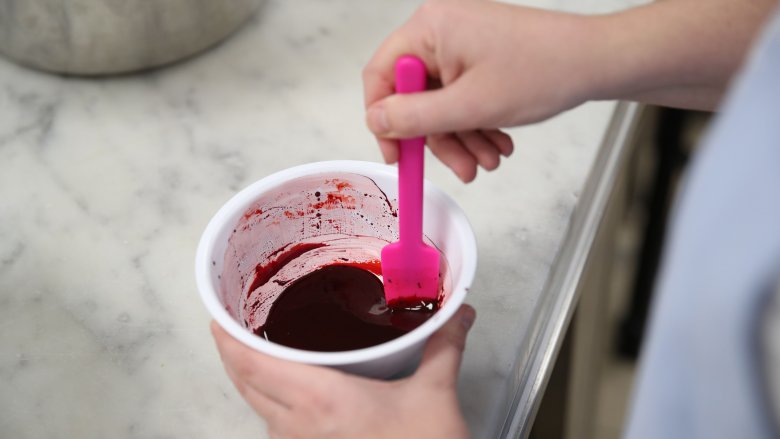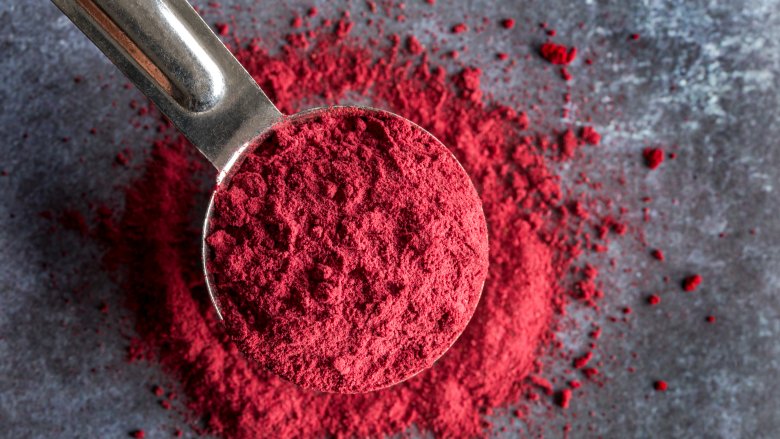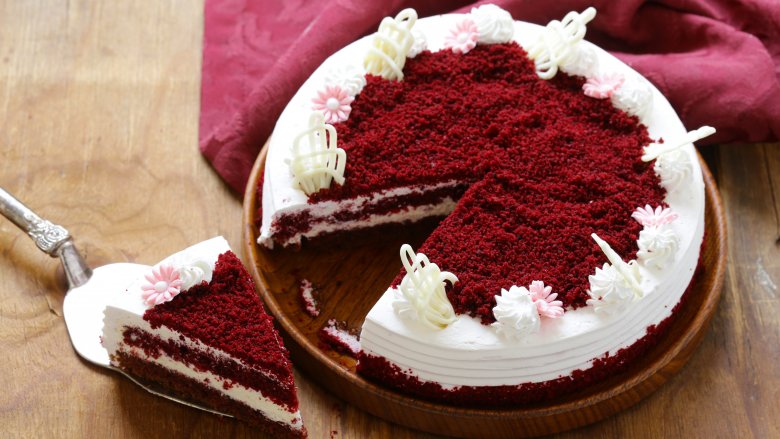The Truth About Red Velvet Cake
Red velvet is everywhere, from cookies to candles. But it was cake that started it all, and seeing it on a dessert menu is still exciting. It's something a little different than the usual chocolate cakes, and for anyone who's not a fan of overly sweet cake, loaded up with sugary, super-sweet frosting, red velvet is probably one of the go-to options.
Plus, it looks cool! It comes in all different shades, and it's even perfect for themed Christmas, Valentine's Day, and Halloween desserts. But what exactly is red velvet cake, anyway? Red isn't really a flavor — even though you know what it tastes like, just like you know what "blue" tastes like. And how did it go from weird gimmick to national favorite? Did you know the red velvet cake we enjoy today isn't anything like the original? It turns out that there's a lot you probably don't know about this Southern favorite — and by the way, it's not that, either.
Velvet cakes were once a big deal
sToday, we think of "red velvet" as just being the name of that one famous cake, but there's a little more to it than that. In the Victorian era, velvet cakes were an actual thing. They came about, says The New York Times, when bakers figured out how to soften the proteins in flour using ingredients like cocoa, cornstarch, or almond flour to create an almost magical process. The cakes that resulted had a finer, smoother texture than other cakes of the time, and to distinguish these softer cakes, they were called "velvet" cakes.
There were no funky colors added to them yet, but the Sunflour Baking Company says they were still known as "luxury" cakes. They were the cakes that would be served at all the fanciest of parties, and they were nothing like the era's other cakes. When you got one of these, you knew you were special.
Other types of cakes were being served at the same time, and they might sound a bit familiar, too. The mahogany cake was based on the delicious mix of cocoa and coffee, and the coarser cake that was also popular at about the same time was called devil's food.
Red velvet cakes weren't always so red
When you look at red velvet cake today, the color is unmistakable. It wasn't always so bright and so, well, red, and that's because the original color came not from food dyes but from a chemical reaction.
According to Bobbie Lloyd, Chief Baking Officer at the Magnolia Bakery (via Mic), there's a funky color change that happens when the cocoa powder, vinegar, and baking soda in a red velvet recipe react and turn the cake from brown to a sort of brownish-red. It's not a great color and certainly one that doesn't stand up to Instagram, so now, we add food dyes to give it that extra pop.
And here's the weird thing — at one time, the reaction was much more pronounced and the red color was much brighter — even before the dyes. According to io9, cocoa powder once contained anthocyanins, which were responsible for the red color not just in red velvet, but also for red colors found in foods like red cabbage. Most of today's cocoa powder, however, contains an alkalizing agent that neutralizes a lot of the acidity and, in turn, the color changing properties. And that's why we have to fancy our red velvet cakes up with a little extra makeup these days.
Red velvet cake was used to sell food dyes
So, if olde timey velvet cakes were a little more natural-looking, why on earth do we have these super-bright red cakes today? The history of exactly how the red velvet cake came about is debated, but according to The New York Times, we do know that one important piece of the puzzle was John A. Adams of the Adams Extract Company.
Extract company? You probably see where this is going.
In 1938, the Food, Drug, and Cosmetic Act was passed, and that made the regulations on food dyes and extract that much more strict. But Adams, inspired by a cake he and his wife and enjoyed at the Waldorf-Astoria, figured he could increase his sales by coming up with a special, bright red cake that called for dye right in the recipe.
So, that's what they did, and that's some brilliant marketing. The company issued a red cake recipe as part of their merchandising, and home cooks across their native Texas absolutely loved it. Their red velvet cake started popping up all over, and once it became a star at cooking competitions across the Midwest, there was just no looking back.
The Waldorf-Astoria also claims some of the credit for the red velvet cake
Here's where things get a little weird. It's hotly debated just who should get credit for inventing the red velvet cake, and part of the credit is claimed by the Waldorf-Astoria Hotel. According to their own archivist, Erin Allsop (via The New York Times), they invented the cake in the 1930s. But other cake historians (and yes, that's a real thing), don't think that's right at all and point to red cakes that were popping up across the country in the same decade, usually around Christmas-time.
But there's a big difference between popularizing and inventing, and it seems as though — like many other events in history — this one is a case of all things coming together and resulting in a perfect storm that catapulted a simple red cake to such a long-lasting popularity.
And the Waldorf-Astoria Hotel has released their recipe, too, says The Telegraph. What makes it so special? It might just be the dark chocolate and the beets.
Red velvet cakes have gone by some pretty awesome other names
Sure, a rose by any other name would probably smell just as sweet, but names are important. You know it as a red velvet cake, but over the course of the decades it's been popular, it's been called some pretty funky things.
Next time you decide to bake a red velvet cake and take it to work, tell everyone it's a flame cake. Not edgy enough? How about a feather devil's food cake?
According to food historian Gil Marks (via Tori Avey), those are both names given to cakes that would become today's red velvet. And there are a ton of them — it was also known as a $300 cake, red mystery cake, red carpet cake, and a Waldorf red cake. Earlier incarnations were called things like the red regal cake, red feather cake, and red devil's food cake, although those tended to be nowhere near as bright as the cakes we know today.
The red velvet cake was shaped by difficult times
Velvet cakes may have been the stuff of fancy parties during the Victorian era, but part of red velvet's enduring popularity has come because of difficult times.
According to Stella Parks, author of BraveTart: Iconic American Desserts (via Splendid Table), once velvet cakes made the leap into the 20th century, the recipes started to change a bit. During the Great Depression, the fact that the recipe called for cocoa powder instead of chocolate bars made this dessert much more affordable (via Eat This, Not That!). Later, buttermilk was also added to the recipe. It sounds weird, but it had an even weirder side effect: the cake started to turn slightly red.
The nation was going through another difficult era when the Adams Extract Company launched their red cake campaign, too. The New York Times says that at the time, butter was being rationed thanks to World War II, but since their recipe called for their bottles of red dye, vanilla, and artificial butter flavoring, that meant it was a way for people to get just a little bit of decadence while still doing their part on the home front.
The difference between red velvet and chocolate cakes
There's a rumor going around that red velvet cake is simply chocolate cake with some extra color added, but that's not true at all. So, what is the difference... aside from the color?
Pretty much everything, notes The Kitchn.
Let's take a look at some basic ingredients. Sure, red velvet cake has chocolate flavors, but recipes call for some kind of natural cocoa powder to supply the hint of chocolate, while a chocolate cake is, well, much, much more chocolatey.
There's also a big difference in the liquids. While chocolate and devil's food cakes call for water and oftentimes coffee for their moistness, red velvet relies on something weird: buttermilk and vinegar. That's what gives it that distinctive tanginess that, if you took a bite with your eyes closed, would tell you that you're eating red velvet.
Then, there's the frosting. While chocolate cakes are a little more versatile, there's really only one kind of frosting that you'll find being slathered on your tangy, slightly chocolatey, definitely-not-chocolate red velvet cake, and that's cream cheese frosting.
And here's the interesting thing — red velvet connoisseurs say (via The New York Times) that part of what sets red velvet apart isn't just the color, but the flavor of the color. Ted Lee of the Lee Brothers feels pretty strongly about it, saying, "The secret to red velvet is the flavor of the red food coloring ... Without the coloring, I think the concept is gone."
Red velvet cake isn't as Southern as you think
When you think of some of the classic cakes popular across the southern section of the U.S., you probably add red velvet to the list. But you might not want to say that in the company of someone who hails from the south, as Southern cookbook author Virginia Willis had this to say to The New York Times: "I find it insulting on some level culturally. It's kind of a weird Southern cake anyway, and it's bizarre the way it's been appropriated." After all, there is a very famous hotel in New York city that claims credit for the cake's invention.
Red velvet — along with other types of red food — is an important part of the Juneteenth and Emancipation Day celebrations, too. It's connected with the end of slavery in the US, and when Adrian Miller was researching his book, Soul Food: The Surprising Story of an American Cuisine, One Plate at a Time, he decided not to include it when the people he interviewed didn't talk about ever having it. In fact, he found it was a "latecomer" to the celebration, and was originally made as a Christmas cake, not as a celebration of freedom.
Red velvet cake was part of an urban legend
There aren't not too many foods that come with their own urban legend, but red velvet is one of them. It shares the story with fudge cake and Neiman Marcus, but the tale is basically the same.
It involves a woman who goes out to eat, asks for the recipe of something particularly delicious, and is given that recipe... then, she's charged an insane amount of money. In order to get her revenge, she releases the recipe to the public. Sounds pretty familiar, right? The Museum of Hoaxes calls it The Rip-Off Recipe Legend, and they say it started in the 1940s with a woman eating at the Waldorf-Astoria. They charged her $100 for their Fudge Cake recipe (the story goes), and by the 1960s, that had become $300 for their red velvet cake recipe.
Even then, the Waldorf-Astoria was going out of their way to prove that it just wasn't true. They started just giving away the recipe for free, and by the 1980s the story moved on to a new big bad corporation: Mrs. Fields.
The red velvet cake shouldn't be as popular as it is
Red velvet is a strange sort of thing. It spread from the U.S. into the U.K., and in 2015, The Telegraph reported that the six locations of London's Hummingbird Bakery sell a whopping 440,000 red velvet cupcakes each and every year — in spite of the fact that only a few years prior, foodies in the U.K. condemned it as a "short-lived gimmick." Red velvet fans say it has something to do with the fact that it's American and therefore, pretty darn cool. But Marcia Mogelonsky, a food and drink specialist with the market analyst firm Mintel, pointed out just how strange the popularity of red velvet is in today's world.
"It is not a flavor, and considering how much food color is put into recipes, in an era in which companies are trying to get the food color out of food, it is a bit odd."
And that's the thing, isn't it? We appeal to fast food giants and snack companies to condemn them for using so many artificial colors and dyes, but boy, do we still love our unnaturally colored red velvet cake! We are getting a little better, though; according to Stella Parks, author of BraveTart: Iconic American Desserts (via Splendid Table), 1940s-era red velvet recipes called for a shocking quarter cup of food coloring.
The secret to achieving perfectly red, red velvet cake
Getting that deep red color in your homemade red velvet cakes can be difficult, and while there are a lot of cake fails out there, cutting into a less-than-red red velvet cake is definitely up there. Fortunately, The Hummingbird Bakery has shared their secret, and it's super easy.
First, use gel food coloring, not liquid. You won't need nearly as much, and you won't be adding all that extra liquid to your cake.
Also, don't just pour it in your batter. Prep it first by mixing it with your vanilla, then mix that with your cocoa. Then, add that to your batter. Easy peasy, velvet squeezey!
Stella Parks, author of BraveTart: Iconic American Desserts (via Splendid Table) has another idea: use red wine. The wine has some of the same components that came into play in the olde timey red velvet recipes, and when you pair it with natural, raw cocoa powder, the ingredients act together to give you a naturally deep burgundy color without the common food dyes.
You can actually make a heart-healthy red velvet cake
Here's some good news: cake doesn't have to be terrible for you. And that comes from nutritionist and dietician Maggie Michalczyk, RDN.
She suggests using something completely different to get the distinctive red color of red velvet, and that's beet powder. Brilliant, right?
She calls beet powder a great alternative to red food dye for a few reasons. Not only is it all natural, but beets contain high levels of nitrates, which help regulate blood pressure and have been shown to contribute to increased stamina, which is brilliant if you're going to be exercising to work off that cake. They also have vitamin C — that's good for the immune system — and a natural sweetness that works surprisingly well in cakes. Have some picky eaters in the house? Always looking for new ways to get them to eat their veggies? That'll just make this one extra rewarding when you sneak it into their birthday cake. It'll be your little secret.
Here's a more historical frosting recipe for your red velvet cake
Everyone knows it's cream cheese frosting with red velvet cake, right? Today, sure, but it wasn't always like that. If you want to make a real, authentic red velvet cake of the original kind, you'll need to skip the cream cheese and reach for something else.
Red velvet's original partner was something called ermine frosting, which is also known by the decided less cool name of boiled milk frosting. It's more delicious-sounding when you put it this way: it's got less sugar and much more butter than buttercream frosting, and it's not-too-sweet and slightly vanilla-y.
How do you make it? Boil ¾ cup of milk with a touch over 3 tablespoons of flour. Keep stirring until it gets an almost pudding-like consistency, then add a dash of sugar and a quarter teaspoon of salt. Dissolve, whisk, and set aside to cool. Once it's cool, you'll whisk in about six ounces of butter and vanilla to taste. Keep whipping, and it'll turn into a light, fluffy, super-silky frosting that's just perfect for your red velvet cake. Promise!
It's so perfect, in fact, that you'll wonder why we ever started using cream cheese. And the strange thing is, no one's sure. According to Philadelphia Cream Cheese (via The New York Times), the first time they ever issued a cream cheese frosting recipe was in the late 1940s. That was some serious ingenuity!
